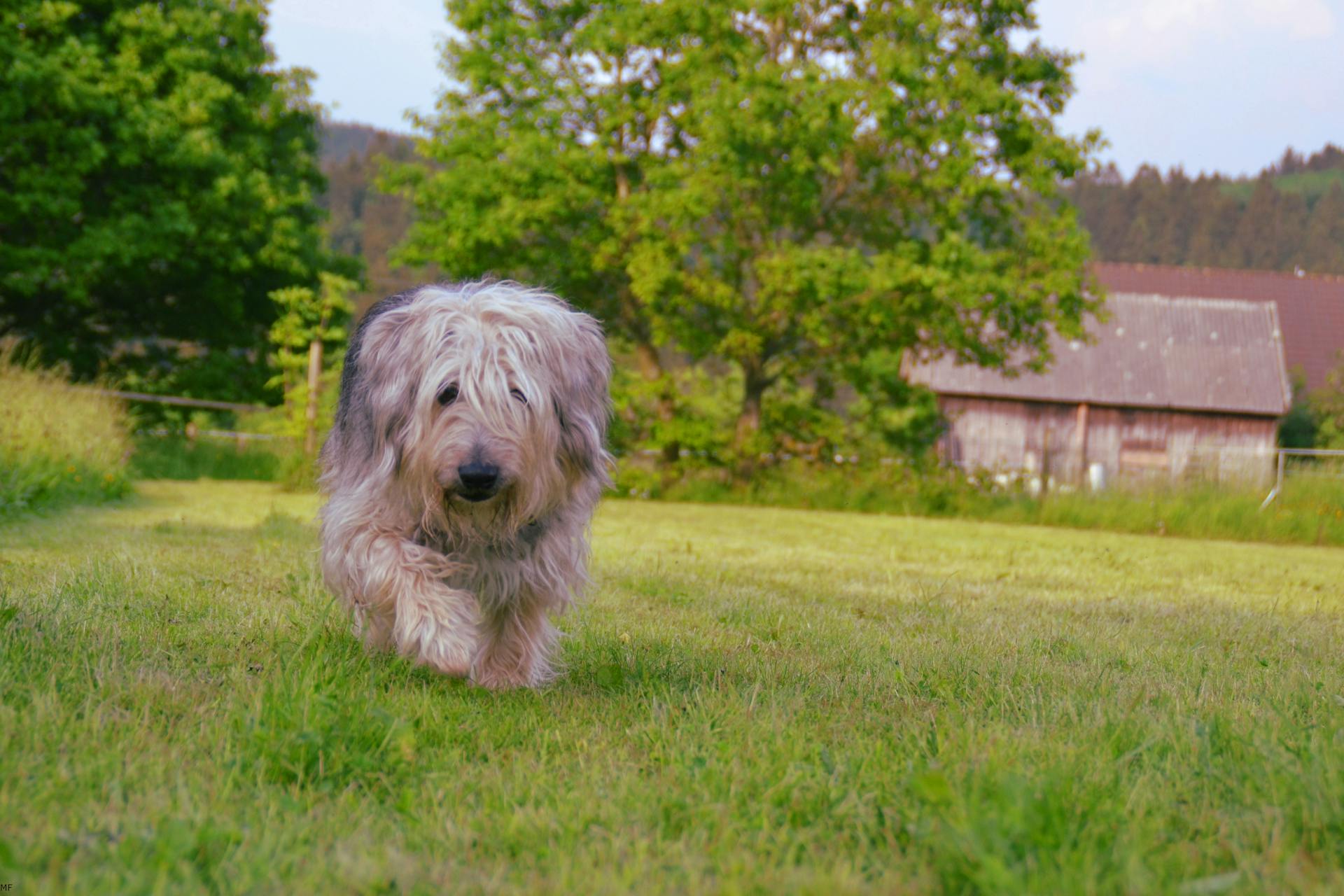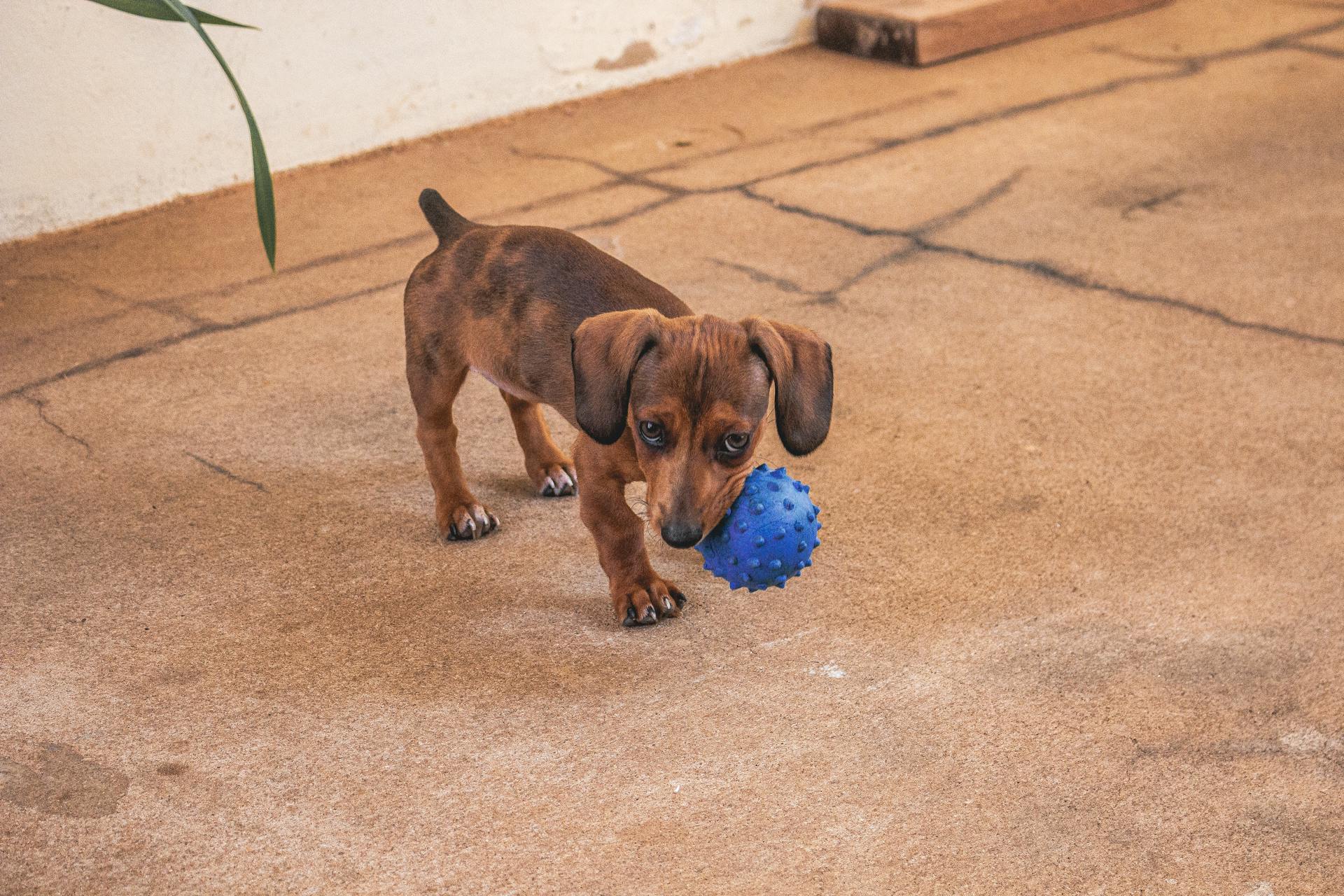
The wiener dog, also known as the dachshund, is a beloved breed known for its short stature and long body.
They are a relatively small dog, weighing between 16 and 32 pounds, and standing between 6 and 10 inches tall.
Wiener dogs are prone to obesity, so it's essential to monitor their food intake and ensure they get regular exercise.
Their short legs may make them seem like they're not built for running, but they can actually be quite energetic and love to play.
You might like: Weiner or Wiener Dog
Physical Characteristics
The dachshund's physical characteristics are quite unique and practical for its original purpose of hunting. They have a long-bodied and muscular build.
Their short stubby legs are surprisingly suitable for digging, with front paws that are disproportionately large and paddle-shaped. This allows them to move efficiently in tight burrows.
A dachshund's skin is loose enough not to tear while tunneling, which is a testament to their original hunting instincts. Their long snout is also a distinguishing feature.
Here are some key physical characteristics of the dachshund breed:
Appearance
A typical dachshund is long-bodied and muscular with short stubby legs. Its front paws are disproportionately large, being paddle-shaped and particularly suitable for digging.
Its skin is loose enough not to tear while tunneling in tight burrows. This unique feature allows dachshunds to chase prey with ease.
Its snout is long, which is perfect for sniffing out small game.
You might like: Long-haired Dachshunds
Coat and Color
Dachshunds come in three coat varieties: smooth coat, long-haired, and wire-haired. The long-haired variety has a silky coat with short featherings on legs and ears.
Red is the most common color among dachshunds. Their base coloration can be single-colored, such as red or cream, or tan pointed, which includes colors like black and tan, chocolate and tan, blue and tan, or isabella and tan.
Wire-haired dachshunds have a unique color referred to as wild boar. Patterns like dapple, sable, brindle, and piebald can also occur on any of the base colors.
Dachshunds in the same litter may be born in different coat colors due to the genetic makeup of their parents. This is why you might see a variety of colors in a single litter.
The Dachshund Club of America and the American Kennel Club consider Double Dapple to be out of standard and a disqualifying color in the show ring.
Personality and Temperament
Dachshunds can be stubborn and refuse commands, especially if chasing a small animal. This is because they have a keen sense for chasing smaller animals, a trait they inherited from their original use as badger hunters.
Dachshunds are often described as playful and friendly, making them great pets for first-time pet parents. They love mental challenges like puzzle games or scent-tracking sports.
Their spunky temperament means playtime with children should be supervised, as they may play too rough for young kids. Children must be taught how to interact with dogs.
Related reading: Are Dachshunds Good Pets
Dachshunds have a strong prey drive, so they might not do well in homes with smaller animals that they might see as something to chase after. This is due to their excellent sense of smell and hunting background.
They can be fiercely loyal, but this also means they can get jealous easily and become lonely if not given enough attention. Dachshunds are best suited for single adults or families with older children.
Dachshunds are known to be clever, lively, and playful, but they can also be stubborn and require patience and consistency when training. Regular exercise and mental stimulation are essential to keep them happy and healthy.
A Japanese study found that Miniature Dachshunds have higher rates of refusing to move while on a walk, barking at outside noises, and aggression towards family members. This highlights the breed's stubbornness and aggression.
Dachshunds are generally good with people they know, but they can be standoffish towards strangers. They may also have a loud bark, which can be managed with training.
Their bodies aren't equipped for toddlers who may try to jump on them, and they don't handle teasing well. Dachshunds may become snappy or extremely obstinate if not socialized properly.
Despite their small size, Dachshunds need regular exercise to stay fit and build strong muscles to support and protect their back. They should lead active lifestyles with multiple daily walks, playtime, and activities to mentally stimulate them throughout the day.
If this caught your attention, see: How to Stop Dog Dominance Aggression with Other Dogs
Health and Care
Dachshunds are prone to back issues due to their long spine and low-to-the-ground stature, which can lead to a range of health problems. Regular exercise is essential to keep your Dachshund's back healthy, but it's also crucial to limit their jumping and provide alternative activities.
To prevent back injuries, try to keep your Dachshund at a healthy weight and install pet stairs or ramps near furniture and beds to limit their jumping. This will help minimize the risk of a back injury.
If your Dachshund does suffer from a back injury, treatment may include anti-inflammatory and pain medications, muscle relaxants, and strict cage rest. In severe cases, surgical correction may be necessary to help your dog regain use of their legs and other functions.
Here are some common signs of back injuries in Dachshunds:
- Trouble walking
- Limping
- Holding head/neck down
- Dragging paws
- Scuffed toenails
Health
Dachshunds are generally a long-lived breed, with an average lifespan of 12-16 years. However, they are prone to certain health issues that can affect their quality of life.

Back problems are a major concern for Dachshunds due to their long spine and low-to-the-ground stature, which can lead to back injuries. This is why regular exercise, but not excessive running or jumping, is essential to keep their back healthy.
A Dachshund's back is vulnerable to injury, so it's crucial to limit their jumping by installing pet stairs or ramps near furniture and beds. This will help prevent accidents and keep them safe.
Dachshunds are also more prone to sinus infections due to their dolichocephalic (long-faced) skull structure. This means they have more nasal lining than short-nosed dogs, making them more susceptible to fungal, bacterial, or other infections.
Some common signs of back problems in Dachshunds include trouble walking, limping, holding their head or neck down, dragging their paws, and scuffed toenails. If you notice any of these symptoms, it's essential to take your Dachshund to the vet for proper diagnosis and treatment.
Treatment for back injuries may include anti-inflammatory and pain medications, muscle relaxants, and strict cage rest. This means no playing, running, or jumping – only short, leashed walks to go to the bathroom are allowed.
If your Dachshund has a slipped disc, surgical correction may be necessary to help them regain use of their legs and other functions affected by the injury.
Recommended read: Weiner Dog Running
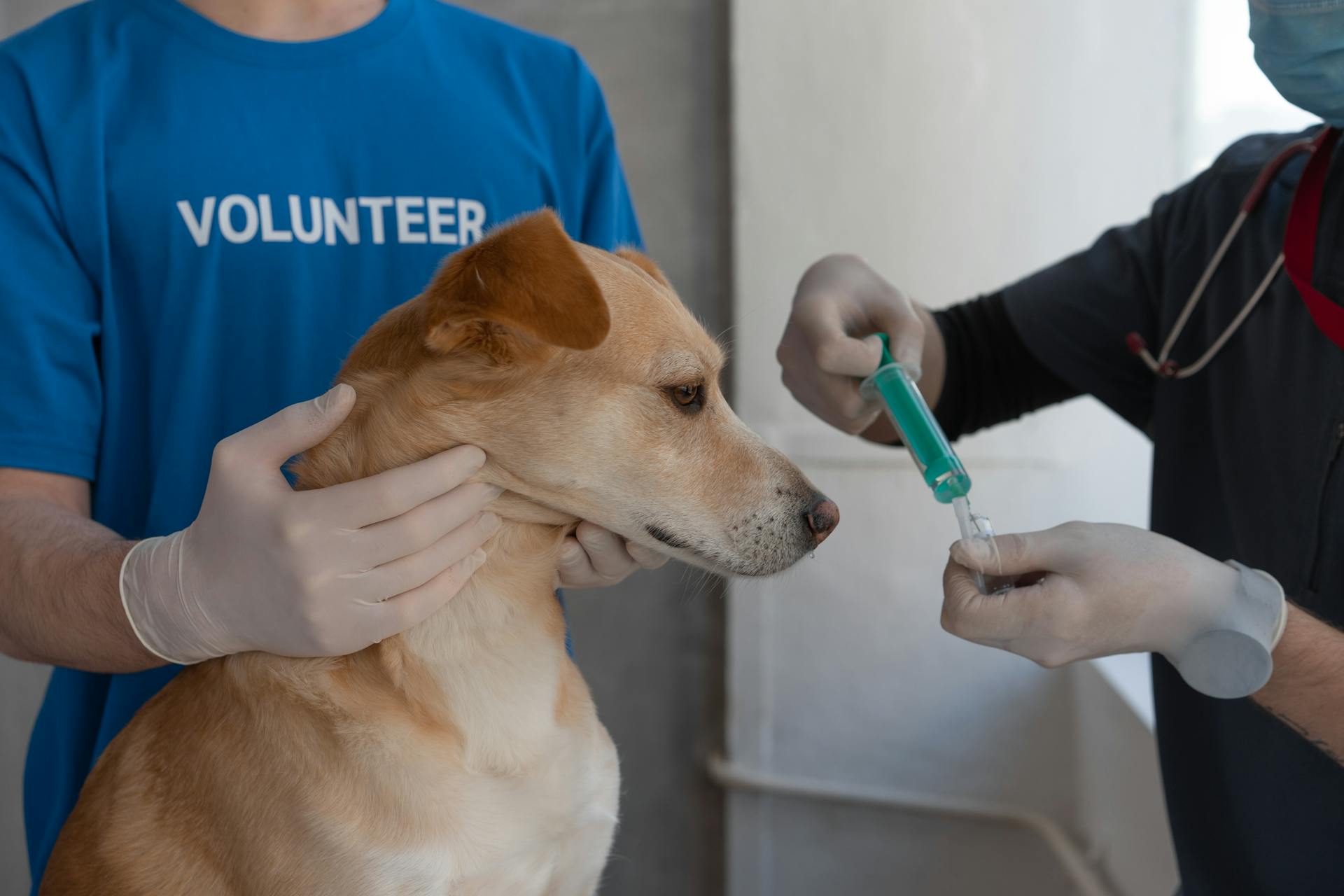
Here are some signs of back problems to watch out for:
- Trouble walking
- Limping
- Holding head/neck down
- Dragging paws
- Scuffed toenails
To care for a Dachshund with back injuries, be sure to support their hind end with one hand and chest with the other when carrying them. This will help prevent further strain on their back.
Discover more: Back Brace for Dachshunds
Care
Dachshunds are tenacious dogs that can be a handful at home, so be prepared to provide alternative activities to keep them busy and prevent damage to your potted plants and yard.
Their high prey drive makes them a poor match for households with pet rodents or other small animals. They usually get along well with other dachshunds but tend to be the top dog in a multi-pet household.
To keep your Dachshund's back healthy and prevent injuries, limit their jumping by installing pet stairs or ramps near furniture and beds. Keeping your Dachshund at a healthy weight also helps minimize the risk of a back injury.
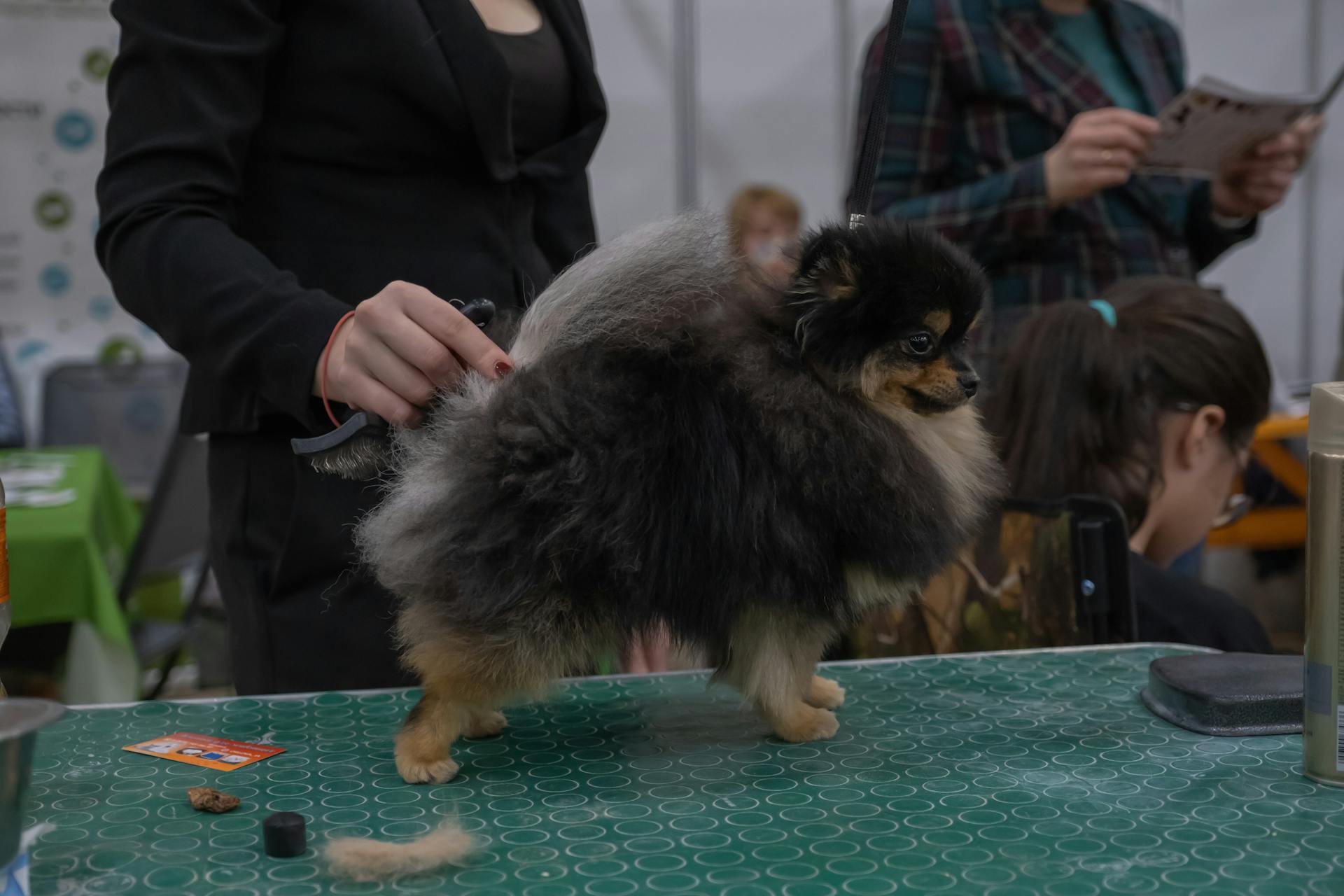
Dachshunds need regular exercise to stay fit and build strong muscles to support and protect their long back. They're not built for extensive running, jumping, or swimming, but they're determined to do it all.
Dachshunds are average shedders with moderate grooming needs, and the type of coat your dog has affects how often you need to groom.
Diet and Nutrition
Your Dachshund's diet plays a huge role in their overall health and well-being. A high-quality food that meets their nutritional needs is essential.
Dachshunds require a specific amount of food based on their size, activity level, age, and other factors. Make sure to monitor your dog's intake and weight.
You should provide your Dachshund with a diet that's formulated for their life stage, whether they're a puppy, adult, or senior.
A diet that's AAFCO-approved ensures that your Dachshund is getting all the necessary nutrients. This is especially important for their joint health.
Suggestion: Problems with Dachshunds
Here are some essential nutrients your Dachshund may need:
- Glucosamine, chondroitin, and MSM to promote joint health
- Omega-3 fatty acids (fish oil) for anti-inflammatory properties and a healthy skin and coat
- Certain antioxidants and vitamins to reduce stress on the eye lens cells and delay cataract development
It's also crucial to avoid feeding your Dachshund table scraps and animal bones, as they can cause serious complications. Stick to a high-quality dog food that's formulated for their specific needs.
The frequency of meals also varies depending on your Dachshund's age. Puppies should be fed three to four times a day, while adult dogs should be fed twice a day.
To determine how much to feed your Dachshund, consult with your veterinarian and the feeding instructions on the bag of food. Overfeeding can lead to serious health issues, so make sure to monitor your dog's weight and adjust their diet accordingly.
Ownership and Adoption
If you're considering bringing a wiener dog into your life, you'll want to think carefully about the costs involved. Dachshund puppies can cost between $500 to $1,500 from a breeder.
If you're set on buying a dachshund, be aware that rare colors or markings may come with health issues. Research thoroughly to find a truly rare but healthy dog.
If adoption is more your speed, start by contacting reputable organizations like the Dachshund Club of America, All American Dachshund Rescue, or Dachshund Rescue of North America. These groups can provide guidance and help you find your perfect wiener dog match.
To test the waters, you may also be able to try foster care to see if a dachshund is right for your home.
Ownership
If you're considering bringing a Dachshund into your family, it's essential to know that they were originally bred as hunting dogs, so they have a strong prey drive and can be quite energetic.
Dachshunds come in two sizes: standard and miniature, with standard dogs weighing around 10-15 pounds more than their miniature counterparts.
They also have three types of coats: smooth, wirehaired, and longhaired, which require regular grooming to prevent matting and tangling.
Dachshunds are ideal pets for many homes, including those with children, as they are lovable and playful.
However, their short legs and paddle-shaped paws do make them prone to back problems, so it's crucial to provide them with a comfortable and supportive living space.
In the past, Dachshunds were used in wartime propaganda, which led to a decline in popularity, but they've since made a comeback as beloved pets.
Today, Dachshunds are one of the most popular breeds in the country, ranking number 12 on the AKC's List of Most Popular Dogs in the U.S. in 2018.
Adopt or Buy
If you're thinking of bringing a Dachshund into your family, you'll need to decide whether to adopt or buy. Adopting a Dachshund can be a rewarding experience, especially if you're looking for a loving companion.
You can start by contacting reputable organizations such as the Dachshund Club of America, All American Dachshund Rescue, or Dachshund Rescue of North America. They will be able to provide guidance and the next steps for adoption.
If you're not sure if a Dachshund is right for you, consider foster care as a trial basis to test if a Dachshund is a good fit for your home.
Dachshund puppies from a breeder can cost between $500 to $1,500. However, be aware that rare colors or markings may come with health issues.
Here are some reputable organizations to consider for adoption:
- Dachshund Club of America
- All American Dachshund Rescue
- Dachshund Rescue of North America
For Everyone
Dachshunds come in two basic sizes: standard and miniature, with standard Dachshunds weighing 16-32 pounds and miniatures weighing 12 pounds and under.
The second major distinguisher for Dachshunds is coat variety, with three distinct types: smooth, longhaired, and wirehaired, with wirehaired Dachshunds being the least common.
Dachshunds are typically less than 9-inches tall, with the distinction between standard and miniature depending more on their weight than height.
Note that Dachshunds have a unique pronunciation, with the first syllable rhyming with "rock", not "cash."
Training and Grooming
Training and grooming are two areas where consistency and patience are key when it comes to your weiner dog. Dachshunds are smart dogs, but they can be independent and willful, making training a challenge. Keep training sessions short and use positive reinforcement to encourage good behavior.
Regular grooming is also essential for your weiner dog's well-being. The type of coat your dog has will determine how often you need to groom. Here are the three main coat types: Longhaired Dachshunds have a thick coat that's typically slightly wavy, and the hair is longer on their neck, chest, and underside.Smooth Dachshunds have a short, smooth, and shiny coat.Wirehaired Dachshunds have a coarse outer coat with a softer undercoat.
Be sure to brush your longhaired weiner dog daily, and bathe them as needed. For smooth and wirehaired Dachshunds, regular nail trims and ear cleaning are a must to prevent problems. Brush your dog's teeth a couple of times a week to maintain good oral hygiene.
Explore further: Dog Grooming for Anxious Dogs
Grooming Needs
Dachshunds have moderate grooming needs, which can vary depending on their coat type. Daily brushing is a must for longhaired dachshunds to prevent matting and tangling.
Regular nail trims are essential to prevent problems with their paws. This is especially important for dachshunds, who are prone to nail issues due to their unique body shape.
Dachshunds shed regularly, with smooth varieties shedding more than others. They may benefit from wearing a sweater in cold weather to stay warm and comfortable.
To maintain good oral hygiene, brush your dachshund's teeth a couple of times a week. This will help prevent bad breath and gum disease.
Here are the different coat types found in dachshunds:
- Longhaired Dachshunds: thick coat with longer hair on the neck, chest, and underside
- Smooth Dachshunds: short, smooth, and shiny coat
- Wirehaired Dachshunds: coarse outer coat with a softer undercoat
Bathing should be done as needed, with more frequent bathing required if your dachshund has skin problems.
Training
Training a dachshund requires patience and consistency. They're smart dogs, but also independent and willful, making them a challenge to train.
Keep training sessions short to avoid losing your dog's attention. Positive reinforcement is key, so be sure to encourage good behavior.
Dachshund puppies need consistent socialization when young to become confident, good-mannered dogs. This helps prevent unwanted behaviors like barking and chasing.
If your dog gets distracted or loses patience, take a break and continue their training later. This will help prevent frustration and keep them engaged.
Curious to learn more? Check out: All about Dogs Dog Training
Comparison and Popularity
Dachshunds are one of the most popular dogs in the United States, ranking 12th in the 2018 AKC registration statistics.
Their popularity extends to urban and apartment dwellers, who make up a significant portion of their fan base. Dachshunds even rank among the top 10 most popular breeds in 76 of 190 major US cities surveyed by the AKC.
You can find organized local dachshund clubs in most major American cities, including New York, New Orleans, Portland, Los Angeles, and Chicago.
Dackel Versus Teckel
In Germany, the widely used term for dachshunds is Dackel, both singular and plural.
Dachshunds are also referred to as Teckel, especially among hunters.
There are kennels that specialize in breeding hunting dachshunds, known as jagdliche Leistungszucht or Gebrauchshundezucht.
These kennels focus on breeding working dogs rather than family pets.
Popularity
Dachshunds are one of the most popular dogs in the United States, ranking 12th in the 2018 AKC registration statistics.
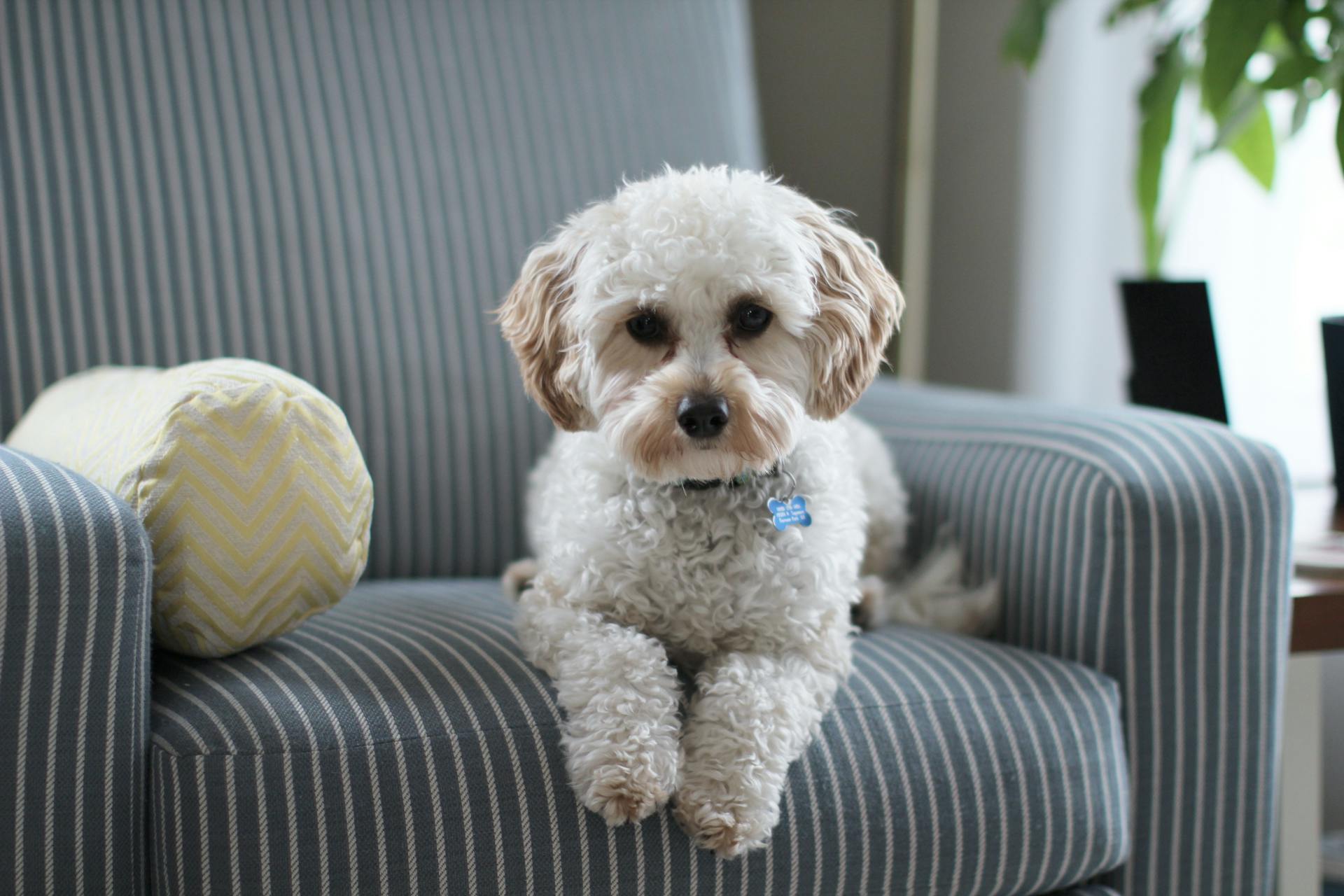
Their popularity extends to urban and apartment dwellers, who rank them among the top 10 most popular breeds in 76 of 190 major US cities surveyed by the AKC.
You can find organized local dachshund clubs in most major American cities, including New York, New Orleans, Portland, Los Angeles, and Chicago.
Specific Needs
If you're considering bringing a wiener dog into your family, you'll want to think about their specific needs.
Wiener dogs are prone to obesity, so it's essential to monitor their food intake and ensure they get plenty of exercise.
They require regular grooming to prevent skin problems and matting of their coat.
Wiener dogs are intelligent and trainable, but they can be stubborn at times.
A daily walk of at least 30 minutes is recommended to keep them happy and healthy.
Their short stature means they can be prone to back problems if they don't get enough exercise and mental stimulation.
Wiener dogs are adaptable to apartment living, but they do need regular exercise and attention.
Frequently Asked Questions
Why is it called wiener dog?
The nickname "wiener dog" comes from the Dachshund's long, narrow build, which resembles a hot dog or sausage. This nickname is a colloquialism that highlights the breed's unique physical characteristics.
Are wiener dogs expensive?
Adopting or buying a Dachshund can cost between $150-$3,500 upfront, while monthly care expenses range from $155-$855+. Learn more about the costs and what to expect in our comprehensive guide.
Do Dachshunds bark a lot?
Yes, Dachshunds are known to bark frequently due to their original hunting breed background, where barking was a crucial skill for tracking prey. Their strong instinct to bark remains a characteristic of the breed.
What are sausage dogs called in America?
In America, Dachshunds are commonly referred to as "wiener dogs" due to their unique body shape resembling a hot dog. This nickname is a popular colloquialism for this beloved breed.
Is a Dachshund different to a sausage dog?
Dachshund and Sausage Dog are actually the same breed, with many nicknames referring to its unique characteristics. Learn more about this lovable breed and its fascinating history
Featured Images: pexels.com

